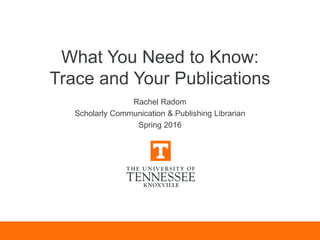
Trace and Your Publications: UT Knoxville
- 1. What You Need to Know: Trace and Your Publications Rachel Radom Scholarly Communication & Publishing Librarian Spring 2016
- 2. Overview • What is Trace? • When would you use it? • What is Green Open Access? • Benefits of depositing work in Trace • Your Subject Librarian
- 3. What is Trace? • Online archive of institutional research • UT’s own open repository • Makes work findable • Makes work accessible • Trace: Tennessee Research and Creative Exchange http://trace.tennessee.edu
- 4. When should you use Trace? Whenever you want to share any of the following: • Electronic theses or dissertations • Peer-reviewed journal articles* • Data sets* • Presentations, white papers, etc. *Often required by funders with public access policies (compliance issue)
- 5. For Theses & Dissertations • Submit to Trace • If desired, request an embargo from the Graduate School • Why an embargo? • Chapter accepted as an article, not yet published • Creative work that will be sent out for consideration as a book
- 6. For Funder Policies • Most federal funders require public access to research resulting from grants they fund • Articles must be available in an open repository (sometimes a specific one) • Data sets must be available in an open repository (sometimes a specific one) • Private funders, too
- 7. For Green Open Access • Gold OA • Green OA / Delayed OA (12 month embargo) • Find OA Journals that Follow Best Practices: doaj.org
- 8. What else besides articles? • Presentations • White papers • Chapters • Artists’ Statements
- 9. Be Aware • You cannot make work public in Trace unless your publication agreement allows • Not sure? Check Sherpa/RoMEO • Sometimes subject to an embargo period (delayed OA, or green OA) • Deposit to Trace now, set embargo, no further action needed • You can negotiate your publication agreements to allow deposit to Trace
- 10. Benefits of Trace I • Items in Trace are indexed by Google Scholar, making your work both findable and accessible • More access = More views = More citations
- 11. Benefits of Trace II • Gives access to “potential users in business, charitable and public sectors, and to the general public” (RCUK Policy on Open Access) • Preservation in your institution’s library collection
- 12. Bigger Questions • Why don’t you own your own work? • Does a publisher need the copyright? No! • Can you retain your copyright? Yes! • Retain select rights via a publication agreement amendment • Offer a license to publish or a CC license • Some journals allow you to keep your ©
- 13. Notes to Researchers • Seek copyright permission for reuse of figures, tables, and the like (2-4 months) • Citation is not enough • Exceptions at UT: SAGE, Wiley-Blackwell (if figures were created by authors) • For graduate students, much easier to go route of article chapter than chapter article (journal’s “right of first publication”)
- 14. Also… • Get an ORCID iD • Use the ORCID search wizards to auto-populate your publications list • On your publications list, add links to articles in Trace
- 15. EndNote & Lit Review Support • Meet with your subject librarian to discuss search strategies, receive assistance with database searches, etc. • Literature Review Guide http://libguides.utk.edu/LitReviews • Endnote/Zotero Guide (with citation manager comparison chart) http://libguides.utk.edu/citeman/
- 16. LIBRARIANS ARE YOUR PARTNERS IN FINDING, WRITING & PUBLISHING. WE WORK WITH YOU, EMPOWERING YOUR RESEARCH & IMPROVING YOUR IMPACT. Your Subject Librarian >> http://s.lib.utk.edu/librarians Scholarly Communication & Publishing Librarian >> rradom@utk.edu
Editor's Notes
- CHANGE CONTACTS ON FIRST & LAST SLIDE IF NEEDED